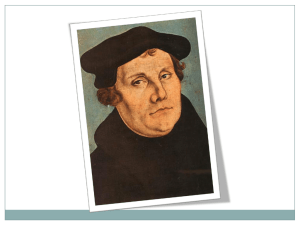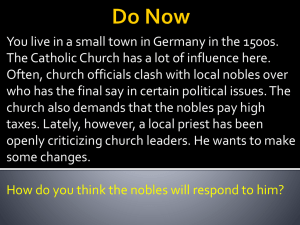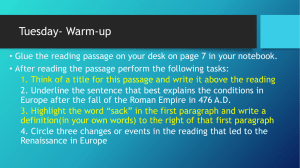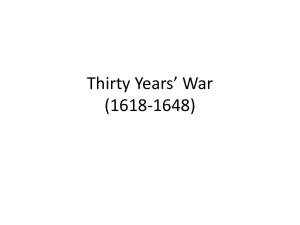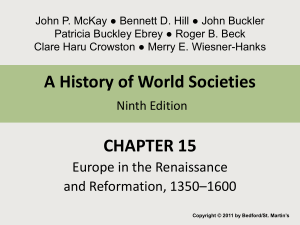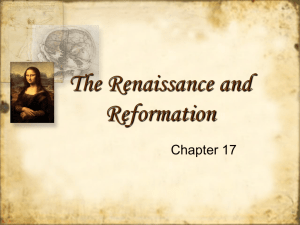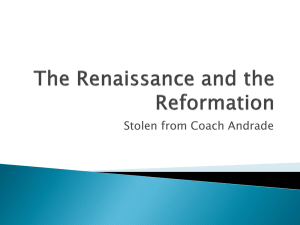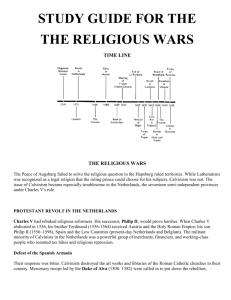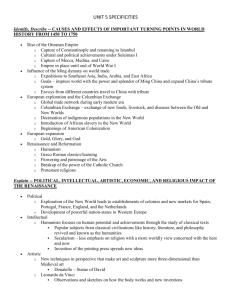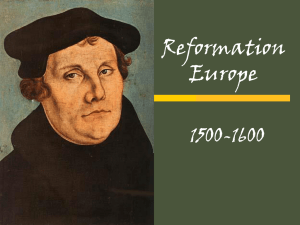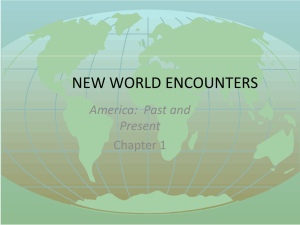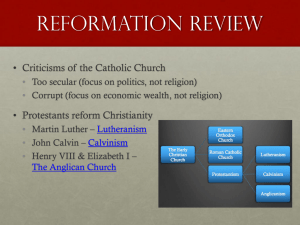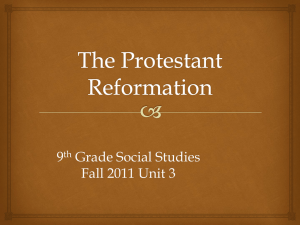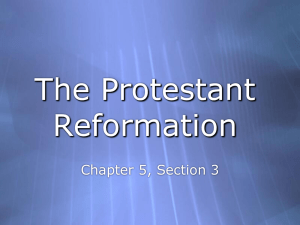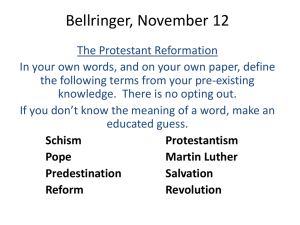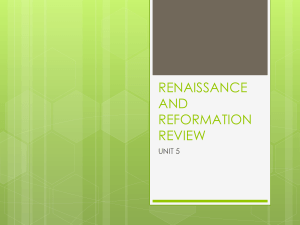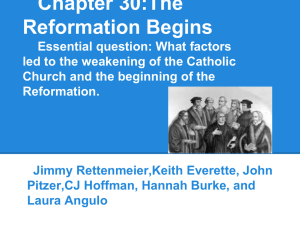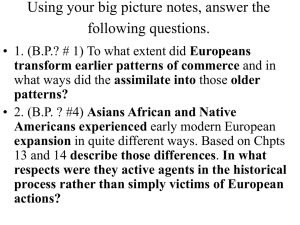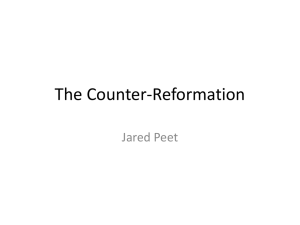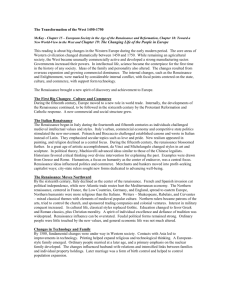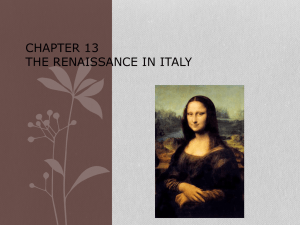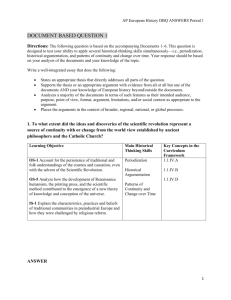THE TRANSFORMATION OF THE WEST, 1450
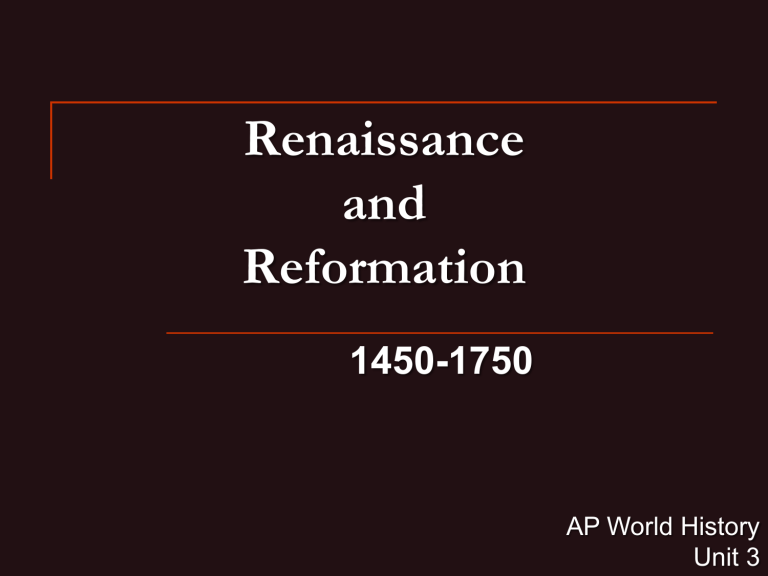
Renaissance and
Reformation
1450-1750
AP World History
Unit 3
Europe during the Renaissance
Italian Renaissance
The Renaissance was the rebirth of art and learning from 1350 to 1600.
Aristocrats, popes, nobles became wealthy patrons and tried to outdo each other.
City-states sponsored innovations in art and architecture.
linear perspective to show depth.
Sculptors created natural poses.
Niccolo Machiavelli
An Italian statesman and writer.
Considered one of the most significant political thinkers of the Renaissance.
His best-known work, The Prince.
Describes cunning and unscrupulous methods for rulers to gain and keep power.
“Machiavellian”
characterized as unscrupulous, treacherous, and cruel toward his political rivals, ”the end justifies the means”
Renaissance Architecture
Simple, elegant style, inherited from the classical Greek and Roman style.
Magnificent domed cathedrals.
Brunelleschi's’ cathedral of Florence.
St. Peter’s Basilica in Rome.
Northern Renaissance
Especially strong in France, England, and
Netherlands.
Focus was more on science, math, and
Christianity.
Preferred language was Hebrew.
Strongly supported by the middle classes and lesser nobles.
Leading figures included Shakespeare,
Erasmus, and Protestant reformers.
Protestant Reformation
Martin Luther (1483-1546)
Attacked the sale of indulgences, 1517.
Attacked corruption in Catholic Church
Argument reproduced with the printing press.
Enthusiastic responses from average Christians.
By mid-16 th century, half of Germany adopted
Lutheranism.
Luther did not actually create Lutheranism, followers did.
Protestant Reformation
Reform spread outside Germany.
Protestant movements popular in Swiss cities and
Netherlands.
Scandinavian kings liked the movement because it removed the Church as a rival.
English Reformation was sparked by King Henry
VII’s desire to get a divorce.
Protestant Reformation
John Calvin.
Organized a model Protestant community in
Geneva in the 1530s.
Calvinist missionaries were successful in France.
Calvinist reformation in Switzerland.
Presbyterian movement in Scotland.
Branches of Christianity
Catholic Reformation
Early attempts to reform
Catholic cardinals and bishops call council in early
15 th century.
Council of Constance deposes rival popes.
Attempts to assert authority over pope
Initial reforms
Catholic intellectuals attack Church corruption.
Emperor Sigismund attempts to reform the church in Germany.
Catholic Reformation
Church’s reaction to Luther and the
Protestants.
Charles V and the Church condemned.
Luther was excommunicated.
King Henry VIII condemned Luther.
Inquisition unleashed on the Protestants.
Spanish use government wealth to fund anti-
Protestant movements.
Catholic Reformation
The Council of Trent.
1545-1563
Organized to reform the Roman Catholic Church.
Attacked corruption
Reaffirmed traditions.
Bible was valued as co-equal.
Catholic Reformation
The Society of Jesus.
Other wise known as “Jesuits”.
Founded by Ignatius Loyola in 1540.
High standards in education.
Combated Protestants with logic, faith, and hard work.
Became confessors and advisors to the kings.
Worldwide missionaries.
Religious Conflicts and Wars.
Wars were as much social and political as they were religious.
Civil War in France.
French Calvinists (Huguenots) and Catholic
League.
Monarchy often a pawn of both sides and nobles.
Lasted 36 years.
1562-1598
Ended with a new dynasty in France.
Religious Conflicts and Wars.
Spanish Armada
War between Catholic Spain and Protestant
England in 1588.
Spilled over from the conflict in the Netherlands.
Questions of the heir to the English throne.
Catholic Scottish Queen or Protestant Elizabeth.
Religious Conflicts and Wars
Protestant provinces of the Netherlands revolted against the rule of Catholic Spain.
Originally began as a revolt of all the Netherlands against Spain.
Eventually split the country into Catholic south
(Belgium) and Protestant north (Holland).
Scottish Presbyterians revolt.
Expelled the Catholic Queen with England’s secret assistance.
Raised her kidnapped son as a Presbyterian.
Religious Conflicts and Wars
The Thirty Years’ War
1618-1648
Most destructive European war up until World War I.
Began as a local conflict in Bohemia.
Eventually involved most of Europe.
Devastated the Holy Roman Empire
Mainly the German states.
Lost 1/3 of the population.
The rise of Sweden and the Hapsburgs as a great powers.
Lowering Spain’s power.
Independence for Holland and Switzerland.
German was no longer “holy”, “Roman”, or an “empire”.
New Religious Map
Scientific Revolution and
Enlightenment
1450-1750
AP World History
Unit 3
Scientific Revolution
The re-conception of the universe.
The Ptolemaic universe.
A motionless earth surrounded by nine spheres.
Could not account for the movements of the planets.
Compatible with the Christian concept of Creation.
The Copernican universe.
The sun was the center of the universe, 1543.
Implied that the earth was just another planet.
Science becomes the new authority and challenges the faith for control.
Johannes Kepler (1564-1642)
Demonstrated planetary orbits.
Scientific Revolution
Galileo Galilei (1564-1642)
Located sunspots, moons on Jupiter, and mountains on the moon.
Theory of velocity, falling bodies anticipated modern law of inertia.
Tried by the Inquisition because his ideas challenged the Papal infallibility.
Scientific Revolution
Isaac Newton (1642-1727)
Mathematical Principles of Natural Philosophy in
1686.
Mathematical explanations of laws govern movements of bodies.
His work symbolized the scientific revolution.
Direct observation
Mathematical reasoning
Enlightenment
Thinkers sought natural laws that governed human society.
Center was France.
Theory of progress was a major ideology.
Applied reason and science to society, government, and laws.
Voltaire (1694-1778)
Considered the father of the Enlightenment.
Religious liberty and individual freedom.
Enlightenment
Adam Smith
Laws of supply and demand determine price.
Montesquieu
Checks and balance in government.
Deism
Accepted the existence of a god.
Denied the supernatural teachings of Christianity.
“God the Clockmaker”.
Ordered the universe according to rational and natural laws.
Enlightenment
Impact of the Enlightenment
Weakened the influence of organized religion.
Encouraged secular values based on reason rather than revelation.
Subjected society to rational analysis.
Promoted progress and prosperity.
Applied science to every day life and made science practical.
